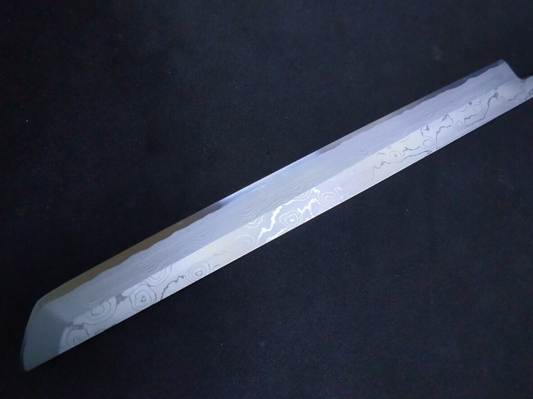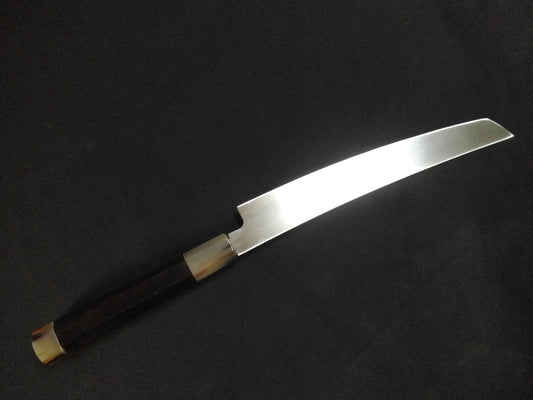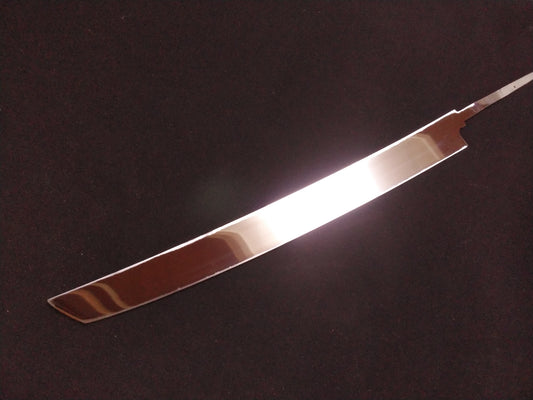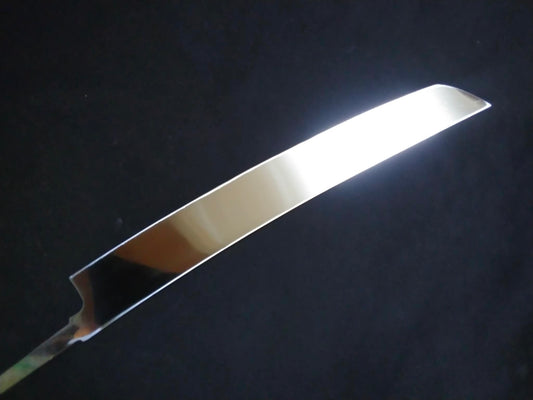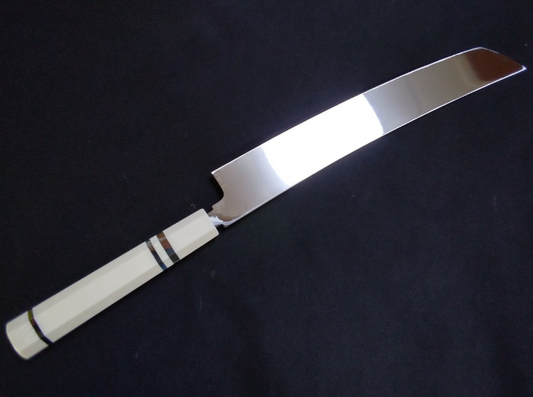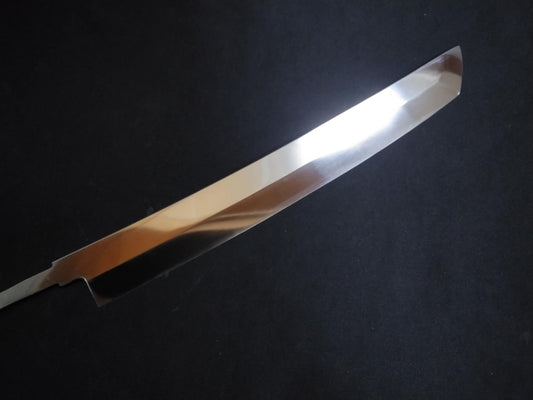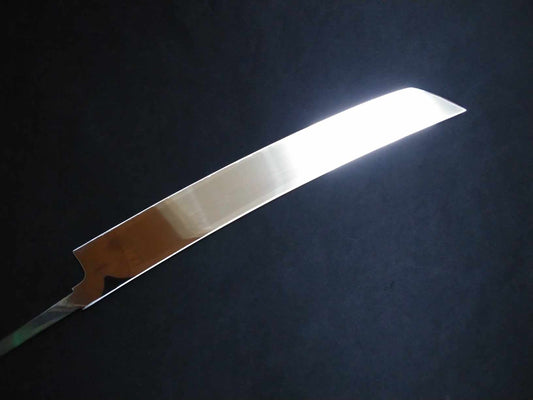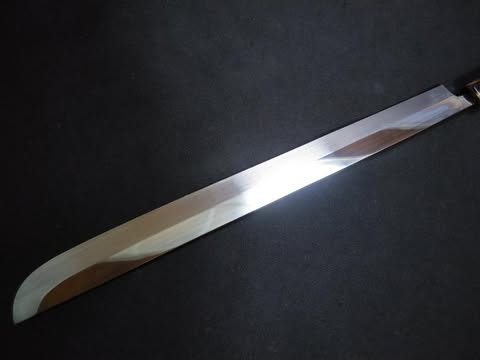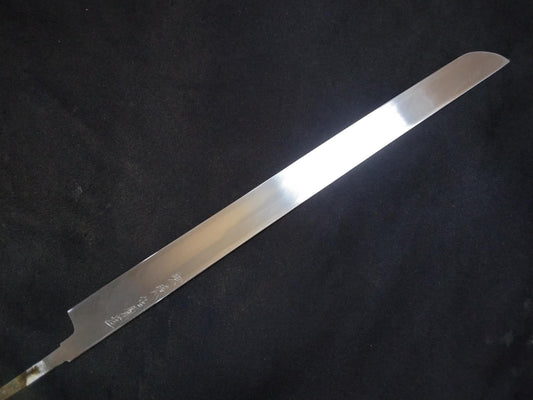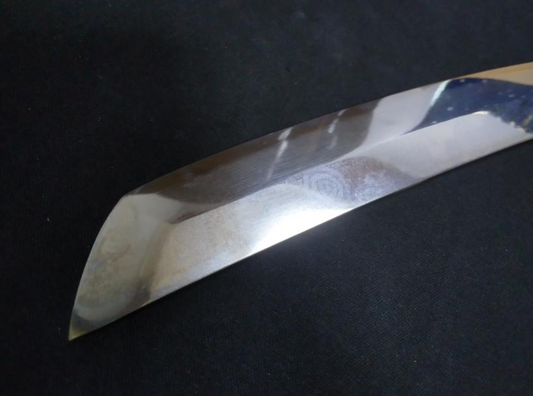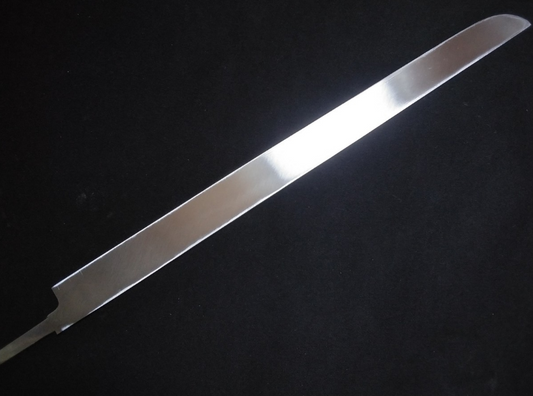
Yanagiba (Sakimaru)
-
Where Katana Heritage Meets Sashimi Perfection
From the spirit of the katana comes the Yanagiba (Sakimaru) — a sashimi knife where a graceful curve transforms performance, beauty, and safety in every slice.
-
Yanagiba(Sakimaru) Japanese Knife Collection
-
Wihte Steel #2 Damascus Yanagiba (Sakimaru) 300mm- Mirror Polished Blur Finish
Regular price $546.00 CADRegular priceUnit price / per -
Super Steel (Honyaki) Yanagiba(Sakimaru) 240mm-Mirror Polished(one side)
Regular price $584.00 CADRegular priceUnit price / per$0.00 CADSale price $584.00 CADSold out -
Super Steel (Honyaki) Yanagiba(Sakimaru) 270mm-Mirror Polished(both sides)
Regular price $682.00 CADRegular priceUnit price / per$0.00 CADSale price $682.00 CAD -
Ginsan Damascus Yanagiba(Sakimaru) 300mm -Mirror Polished(both sides)
Regular price $810.00 CADRegular priceUnit price / per$0.00 CADSale price $810.00 CAD -
Super Steel (Honyaki) Yanagiba(Sakimaru) 330mm-Mirror Polished(both sides)
Regular price $812.00 CADRegular priceUnit price / per$0.00 CADSale price $812.00 CAD -
Ginsan (Honyaki) Yanagiba (Sakimaru) 270mm -Mirror Polished(both sides)
Regular price $960.00 CADRegular priceUnit price / per$685.00 CADSale price $960.00 CAD -
Super Steel (Honyaki) Yanagiba(Sakimaru) 360mm-Mirror Polished(both sides)
Regular price From $980.00 CADRegular priceUnit price / per$0.00 CADSale price From $980.00 CADSold out -
Ginsan (Honyaki) Yanagiba(Sakimaru) 300mm -Mirror Polished(both sides)
Regular price $1,000.00 CADRegular priceUnit price / per -
White Steel #2 (Honyaki-Mizuyaki) Yanagiba (Sakimaru) 300mm-Mirror Polished(one side)
Regular price $1,000.00 CADRegular priceUnit price / per$0.00 CADSale price $1,000.00 CAD -
White Steel #2 (Honyaki) Yanagiba (Sakimaru) 330mm-Mirror Polished(one side)
Regular price $1,200.00 CADRegular priceUnit price / per$0.00 CADSale price $1,200.00 CADSold out -
Ginsan Damascus Yanagiba(Sakimaru) 400mm-Mirror Polished(both sides)
Regular price $1,300.00 CADRegular priceUnit price / per$0.00 CADSale price $1,300.00 CAD -
White Steel #2 (Honyaki-Mizuyaki) Yanagiba (Sakimaru) 360mm-Mirror Polished(one side)
Regular price $1,300.00 CADRegular priceUnit price / per -
Blue Steel #2 (Honyaki-Mizuyaki) Yanagiba (Sakimaru) 360mm -Mirror Polished(one side)
Regular price $1,590.00 CADRegular priceUnit price / per -
ZDP189 Yanagiba (Sakimaru) 420mm-Mirror Polished(both sides)
Regular price $2,100.00 CADRegular priceUnit price / per$0.00 CADSale price $2,100.00 CADSold out
KIREAJI's Three Promises to You
-

1. Forged in the Legacy of Sakai
From Sakai City—Japan’s renowned birthplace of professional kitchen knives—each blade is crafted by master artisans with over six centuries of tradition. Perfectly balanced, enduringly sharp, and exquisitely finished, every cut carries the soul of true craftsmanship.
-

2. Thoughtful Care for Everyday Use
Every knife includes a hand-fitted magnolia saya for safe storage. Upon request, we offer a complimentary Honbazuke final hand sharpening—giving you a precise, ready-to-use edge from day one.
-

3. A Partnership for a Lifetime
A KIREAJI knife is more than a tool—it is a lifelong companion. With our bespoke paid aftercare services, we preserve its edge and beauty, ensuring it remains as precise and dependable as the day it first met your hand.
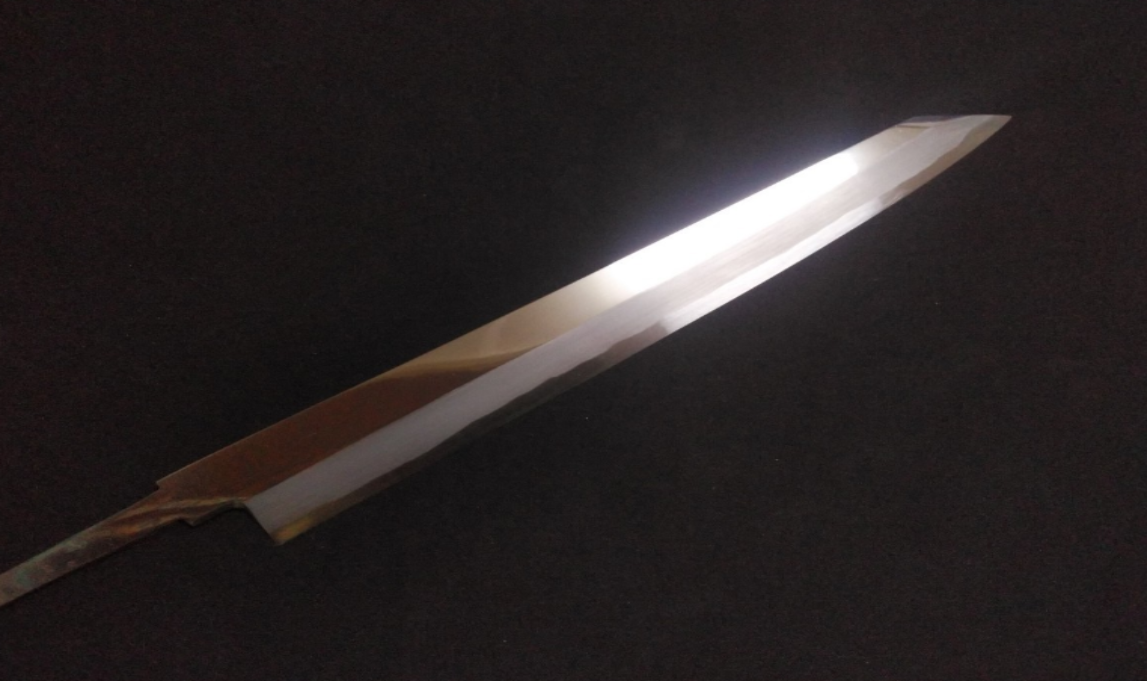
Why Many Product Photos Show Only the Blade
At KIREAJI, every knife is made to order in Sakai, Japan. Photos show the blade before the handle is attached, allowing artisans to perfect the balance and edge for your specific order. Your knife arrives fully finished — tailored just for you.

Global Delivery from Sakai
Across the world, discerning cooks seek authentic Japanese knives from Sakai — Japan’s legendary knife-making city with over 600 years of tradition.
At KIREAJI, we work alongside master artisans in Sakai to fulfill that desire, shipping genuine handcrafted knives directly from the workshop to kitchens worldwide.
Yanagiba (Sakimaru)
-
-
When it comes to traditional Japanese sashimi knives, the Yanagiba is the gold standard, while its variation, the Yanagiba (Sakimaru), offers a distinctive design for those seeking something unique. Understanding their differences is essential to choosing the right blade for your needs.
-
Yanagiba – The Classic Choice
-

The Yanagiba is Japan’s most common sashimi knife, named for its resemblance to willow leaves. Its long, slender blade with a gentle curve is perfect for pull cuts, producing clean, beautiful slices of sashimi. Easy to sharpen and versatile, it’s a favorite among both professionals and beginners.
-
Yanagiba (Sakimaru) – Elegance with a Rounded Tip
-

The Yanagiba (Sakimaru) stands out with its rounded tip and thicker blade, giving it more weight and presence. While visually striking, its tip is less suited for highly precise work, and maintaining its shape is more challenging—sharpening gradually lowers the tip over time.
-
Price and Selection Tips
Yanagiba (Sakimaru) knives are generally more expensive than standard Yanagiba of the same length, as their design requires a larger steel billet, increasing material costs. When choosing between them, consider your preferred cutting style, how often you need tip precision, and your budget.
For most chefs, the Yanagiba offers practicality and ease of use. The Yanagiba (Sakimaru), however, appeals to those who value aesthetics, weight, and a distinctive feel in the hand.
Yanagiba (Sakimaru): A Harmonious Blend of Elegance and Purpose
-

With its curved, sword-like tip and refined balance, the Yanagiba (Sakimaru) offers elegant performance while maintaining the precision expected of a true sashimi blade.
-
Why Is the Tip of the Yanagiba (Sakimaru) Knife Rounded?
-
A small curve with big meaning—blending katana heritage, precision cutting, and the grace of the chef.
The Yanagiba (Sakimaru) is Japan’s iconic sashimi knife variation, prized for its ability to create clean, elegant slices with the pull-cut technique. Instead of a pointed tip, it features a graceful curve—a detail that’s as functional as it is beautiful.
-
1. A Katana-Inspired Aesthetic
The rounded tip echoes the kissaki of a Japanese sword, adding poise and visual elegance. In open kitchens, where the chef’s movements are part of the performance, this design transforms the knife into an extension of the chef’s artistry.
-

2. Precision Without Damage
A pointed tip can pierce too deeply, risking uneven cuts. The Yanagiba (Sakimaru)’s rounded tip glides through delicate fish like fugu, ensuring smooth, glossy slices that preserve texture and flavor.
-
3. Safety and Durability
The rounded end reduces the risk of chipping, accidental stabs, and damage to the cutting board—helping chefs maintain focus during high-pressure service.
-

4. A Fusion of Traditions
The Yanagiba (Sakimaru) blends the flowing elegance of the Kansai Yanagiba with the practicality of the Kanto Takohiki. It’s a heritage-driven innovation shaped by regional styles and modern needs.
-
In just a few millimeters of curvature, the Yanagiba (Sakimaru) captures the essence of Japanese craftsmanship—where beauty, performance, and safety unite in perfect harmony.
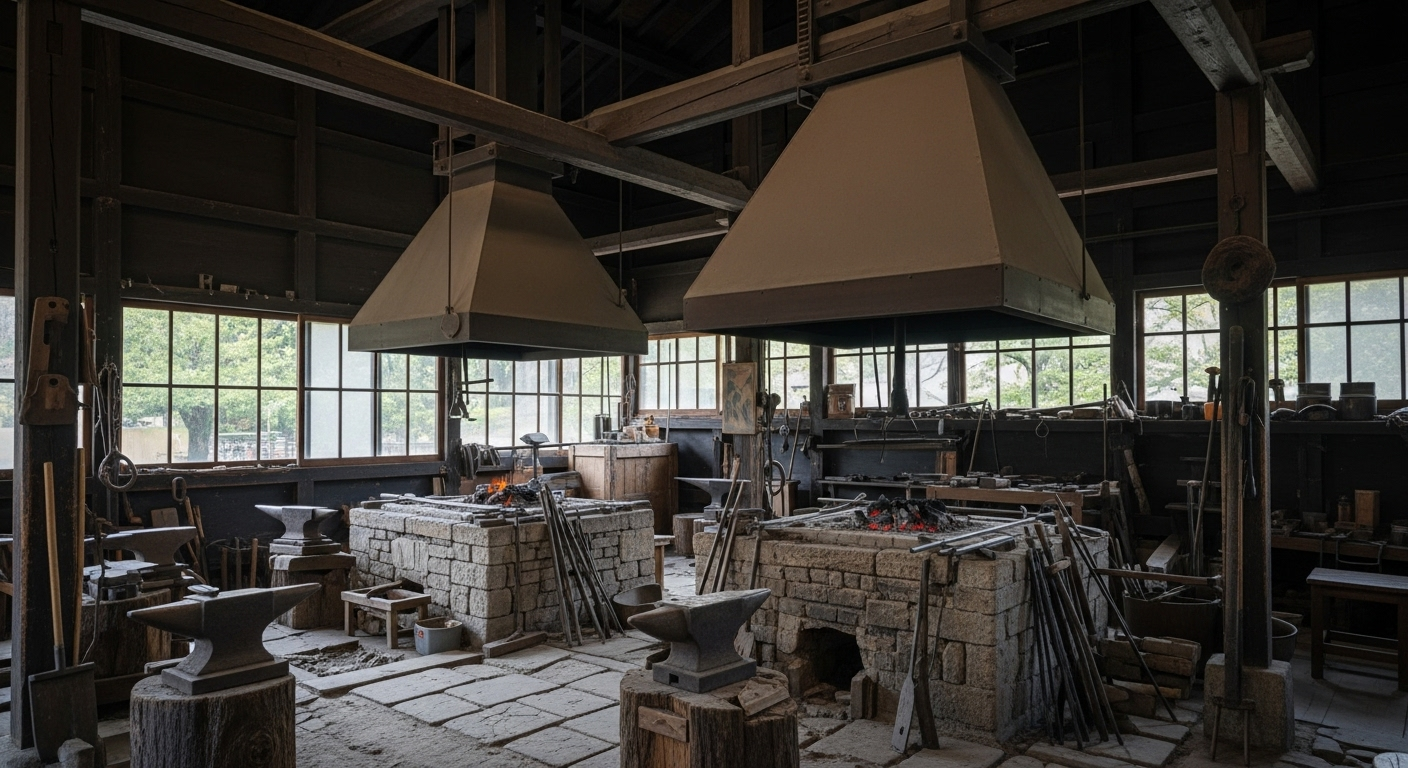
FAQ About Yanagiba(Sakimaru)

Q1. What is a Yanagiba (Sakimaru)?
The Yanagiba (Sakimaru) is a traditional Japanese slicing knife designed for sashimi, distinguished by its gracefully rounded tip that recalls the kissaki of a Japanese katana. While it shares the same core function as a standard Yanagiba, its design is particularly admired by sushi chefs for its fluid handling and striking appearance, making it both a functional tool and a visual centerpiece in professional kitchens.
Q2. Why is it called “Sakimaru”?
The term “Sakimaru” literally means “rounded tip.” This design provides both functional and aesthetic advantages. The elegant curve evokes the silhouette of a Japanese sword, lending grace and prestige in open kitchens or sushi counters. Functionally, the rounded tip reduces cutting resistance, minimizes the risk of accidental piercing, and supports precise, controlled slicing motions.
Q3. What are the differences between a standard Yanagiba and a Sakimaru Yanagiba?
Both knives are single-beveled and designed for sashimi, but they differ in their details. The standard Yanagiba has a sharp pointed tip for precise piercing and trimming, while the Sakimaru features a rounded, sword-like profile. In use, the Sakimaru glides more smoothly during long draw cuts and provides slightly greater control. Aesthetically, it has a more refined and dramatic presence, making it the choice of chefs who value both performance and presentation.
Q4. What are the advantages of the rounded tip?
The rounded tip enhances slicing performance by reducing drag, allowing the blade to glide through delicate fish with minimal resistance. It also improves durability, as it is less prone to chipping than sharply pointed tips. Visually, it transforms slicing into a graceful performance, while in practice, it supports precise decorative cuts and subtle control.
Q5. Who should choose a Sakimaru Yanagiba?
This knife is best suited for professional chefs, sushi masters, and serious enthusiasts who value both aesthetics and precision. It appeals to those who want their knife not only to perform flawlessly but also to enhance the artistry and presentation of their work.
Q6. Is the Sakimaru only for professionals, or can home cooks use it too?
While the Sakimaru is most often seen in professional kitchens, dedicated home cooks can also enjoy its advantages. For those passionate about Japanese cuisine and sashimi, it provides not just functionality but also a sense of tradition and artistry. However, because of its length and precision, it requires care, proper storage, and regular sharpening to be used effectively at home.

A Razor-Sharp Knife and the Birth of Sashimi
Sashimi is more than raw fish—it is tradition, art, and precision, a cuisine that could only have emerged in Japan. At its heart lies the Japanese knife, whose ultra-sharp edge made this culinary culture possible. This article explores how the evolution of these blades shaped sashimi, and why precision cutting remains its very foundation.
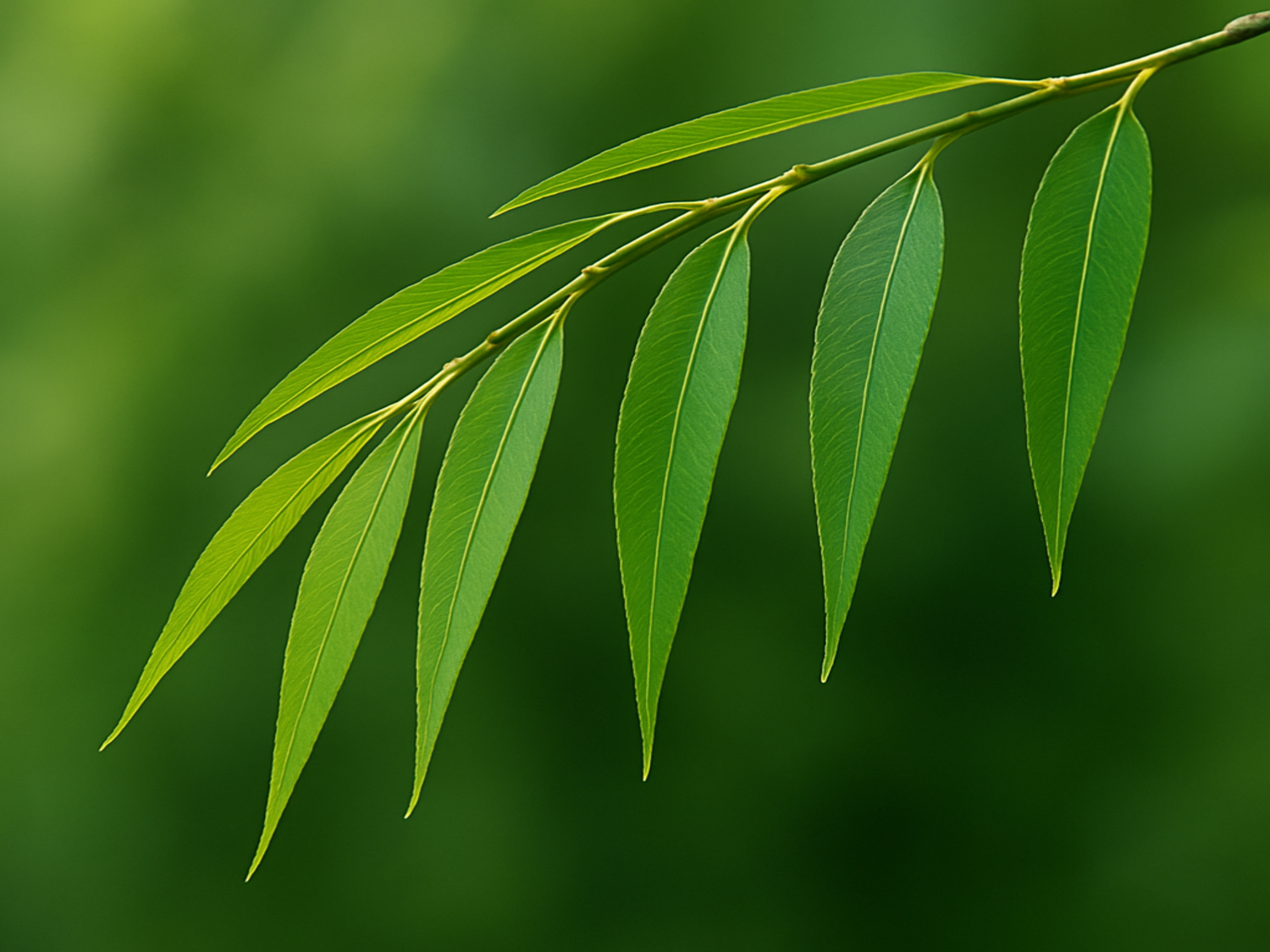
What is a Japanese fish knife called?
Learn about the Yanagiba, Japan's iconic fish knife, and how its design ensures precision in sushi and sashimi preparation. Discover its unique features, care tips, and why it's a must-have for any seafood enthusiast.

The Soul of Craftsmanship
-
The Essence of Yanagiba Knives: Where Tradition Meets Precision
The Yanagiba knife is an essential tool for preparing sashimi and other delicate dishes. Every detail—from selecting the steel to the final honing of the edge—is attended to with no compromise. Special focus is given to the ura-suki (concave back) and the blade angle, since even the slightest imperfection can affect performance. Each knife is carefully adjusted by hand until it reaches its optimal state.
-
But honing a Yanagiba knife is not just about sharpness. It is about creating the perfect balance between precision and smoothness, allowing the blade to glide effortlessly through ingredients while enhancing their natural beauty and flavor. For this reason, both the front and back of the blade are meticulously evaluated at every stage.
-
Above all, our Yanagiba knives are designed with the chef’s satisfaction in mind. They are crafted to feel natural in the hand, providing comfort even during long hours of use. More importantly, our goal is to forge a knife that inspires chefs to say:
“This knife elevates my dishes to another level.”
That moment of connection is the true reward for us as craftsmen. -
Each Yanagiba carries the unseen passion and dedication of its maker. By preserving tradition while embracing new techniques, we continue to refine and innovate. We invite you to experience the unparalleled sharpness and elegance of the Yanagiba knife—a blade where craftsmanship and culinary artistry meet.
How Japanese Knives Are Made: The Sakai Tradition
VIDEO PROVIDED: JAPAN TRADITIONAL CRAFTS AOYAMA SQUARE (YOUTUBE)
-
Sakai Forged Blades — Six Centuries of Unrivaled Craftsmanship
Loved by chefs around the world and trusted by 98% of Japan’s top culinary professionals, Sakai knives are more than tools—they are the living legacy of over 600 years of master craftsmanship.
-
At KIREAJI, we work directly with the Shiroyama Knife Workshop in Sakai, Japan, ensuring every blade is hand-forged, finished to perfection, and shipped straight from the workshop to kitchens across the globe. No middlemen. No mass production. Only authentic, artisan-made knives, crafted to elevate your cooking for a lifetime.


